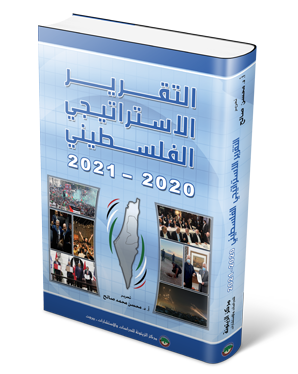Al-Zaytouna Centre for Studies and Consultations has published the Palestine Strategic Report 2020–2021 (PSR), in Arabic, and is offering it for free download (English version will be published soon). It discusses the Palestine issue during those years, offering a wealth of data, up-to-date statistics and analyses, in addition to an outlook of future events.
The 480-page PSR was edited by Prof. Dr. Mohsen Mohammad Saleh, written by 15 specialized researchers, and reviewed by three consultants. It consists of eight chapters and an index.
|
>> Click here to download: Book: The Palestine Strategic Report 2020-2021 |
The first chapter discusses the internal Palestinian scene, which includes the reconciliation process, putting the Palestinian political house in order, and holding elections and their cancellation, which led to a crisis between the Fatah leadership and most Palestinian forces. It also discusses the status of the Palestinian factions and their popularity, and studies the impact of the Palestinian situation on the institutions of the Palestine Liberation Organization (PLO) and the Palestinian Authority (PA), including the PA decision to resume security coordination.
The second chapter displays the Palestinian demographic and economic indicators, which include the Palestinian population worldwide, the demographic characteristics of Palestinians, the demographic growth trends, and Palestinians outside Palestine and the right of return. The chapter discusses also the economic indicators in the West Bank (WB) and the Gaza Strip (GS); Gross domestic product (GDP); GDP per capita, public debt and general budget; Employment, unemployment and poverty; Industrial and agricultural activities and trade; Foreign aid and its effects; in addition to the economic repercussions of the GS siege. It also discusses the outlook for PA economic performance 2022–2023.
The third chapter is about the Land and the holy sites. It discusses the latest developments concerning Jerusalem, holy sites and settlement expansion, Israeli targeting of Islamic and Christian holy sites, the population in Jerusalem under occupation, the eviction attempts, Judaization and settlements, Israeli settlement expansion in WB, the Separation Wall and Barriers in WB, demolition of houses and structures, confiscation of lands, and the Israeli exploitation of water resources in WB.
The fourth chapter is about the aggression, resistance and the peace process. It discusses Israeli aggression, the escalation with Gaza Strip (GS) and the Sword of Jerusalem Battle (dubbed by Israel Operation Guardian of the Walls), which has showed the increasing power of resistance, and it analyzes the repercussions of the battle at various levels. The chapter also discusses various forms of resistance in the West Bank, and monitors the locations and development of resistance operations. It reports on the Israeli killed and wounded and the Palestinian killed and wounded in WB and GS. It also discusses the peace process, and explains how the occupation is seeking to impose its vision of the peace settlement and the final status issues.
Chapter five discusses the Israeli scene, including the most prominent Israeli political, demographic, economic and military developments. In addition, it discusses the internal political situation including holding elections, the participation of the 1948 Palestinians and the formation of the Netanyahu and Bennett governments.
This chapter also explores the Israeli demographic indicators, such as the population of Israel, Jewish immigrants to Israel, world Jewish population, Israeli economic indicators such as Israeli GDP, GDP per Capita, government’s income and expenditure, trade, Israel exports and imports, and US aid to Israel. As for the Israeli military indicators, they include appointments and structural changes, manpower, military plans and directions, military maneuvers, arms and arms trade, and the military budget. At the end of the chapter, the Israeli position on the internal Palestinian situation is discussed.
Chapter six discusses the Palestine issue and the Arab world. It explores the positions of the League of Arab States concerning the Palestine issue and the schism, the Palestinian reconciliation, the position on Trump’s plan and the peace process, positions and roles of some key states, such as Egypt, Jordan, Syria, Lebanon, Saudi Arabia, GCC countries, and others. It also discusses developments concerning political and economic normalization of some Arab countries with Israel, in addition to the popular Arab position and its trends.
As for chapter seven, it is about the Palestine issue and the Muslim world. It discusses the policy of the Organisation of Islamic Cooperation (OIC) and other Muslim countries towards the Palestine issue. The Turkish interest in Palestine besides its tension and interests with Israel, in addition to the Turkish political and economic relations with Israeli and Palestinian parties. Iran’s position on the “deal of the century,” and its relations with Palestinian resistance factions are also discussed, in addition to the responsiveness of the Muslim public to the Palestine issue, and the normalization and Israeli relations with various Muslim Countries.
The eighth chapter, which is the last one, discusses the Palestine issue and the international scene. It studies the stances of the Quartet, UN and international organizations, in addition to positions of the US, EU, BRICS (Brazil, Russia, India, China and South Africa), Japan and other countries towards the Palestine issue. It displays the most important future changes, which may be opportunities or challenges to Israel’s international relations, and finally the chapter offers some recommendations on international support of the Palestine issue.
The PSR is one of al-Zaytouna’s most important academic studies, published periodically in both English and Arabic. Today, it can be surely asserted that PSR is a must reference for every researcher and academic who are interested in the contemporary developments of the Palestine issue. The PSR reviews biennially the various developments concerning the Palestinian question in a comprehensive, objective and academic manner. It offers a wealth of data, up-to-date statistics, and analyzes and offers an outlook of future events with strategic visions.










Leave A Comment